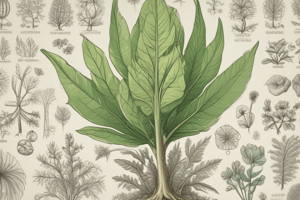Podcast
Questions and Answers
Which type of plant tissue is characterized by dead cells with thick, lignified cell walls?
Which type of plant tissue is characterized by dead cells with thick, lignified cell walls?
- Sclerenchyma tissue (correct)
- Parenchyma tissue
- Phloem tissue
- Collenchyma tissue
What is the primary function of meristematic tissue in plants?
What is the primary function of meristematic tissue in plants?
- Support and protection
- Water and mineral transportation
- Storage and photosynthesis
- Plant growth and development (correct)
What is the primary function of xylem tissue?
What is the primary function of xylem tissue?
- Support and protection
- Sugar and nutrient transportation
- Water and mineral transportation (correct)
- Storage and photosynthesis
Which type of plant tissue is responsible for plant growth and development?
Which type of plant tissue is responsible for plant growth and development?
What is the primary function of phloem tissue?
What is the primary function of phloem tissue?
Which type of plant tissue is characterized by living cells with thin cell walls?
Which type of plant tissue is characterized by living cells with thin cell walls?
What is the primary function of collenchyma tissue?
What is the primary function of collenchyma tissue?
What is the primary function of parenchyma tissue?
What is the primary function of parenchyma tissue?
What is the main characteristic of sclerenchyma tissue?
What is the main characteristic of sclerenchyma tissue?
Flashcards are hidden until you start studying
Study Notes
Plant Tissue
Definition
- Plant tissue is a group of similar cells that perform a specific function in a plant.
Types of Plant Tissues
- Meristematic Tissue
- Found in areas of growth, such as tips of shoots and roots
- Cells are undifferentiated, able to divide and differentiate into various cell types
- Responsible for plant growth and development
- Permanent Tissue
- Derived from meristematic tissue
- Cells are differentiated, specialized for specific functions
- Examples: parenchyma, collenchyma, sclerenchyma, xylem, and phloem
Functions of Plant Tissues
Parenchyma Tissue
- Function: storage, photosynthesis, and secretion
- Characteristics: living cells, thin cell walls, able to divide
- Examples: mesophyll cells in leaves, cortex cells in stems and roots
Collenchyma Tissue
- Function: support, structure, and protection
- Characteristics: living cells, unevenly thickened cell walls, flexible
- Examples: cells in petioles, stems, and leaves
Sclerenchyma Tissue
- Function: support, protection, and structure
- Characteristics: dead cells, thick, rigid cell walls, lignified
- Examples: fibers in stems, sclereids in seeds and fruits
Xylem Tissue
- Function: water and mineral transportation
- Characteristics: dead cells, thick, lignified cell walls, tracheids and vessels
- Examples: tracheids in stems, vessels in roots and stems
Phloem Tissue
- Function: sugar and nutrient transportation
- Characteristics: living cells, thin cell walls, sieve cells and companion cells
- Examples: sieve tubes in stems, companion cells in leaves
Definition of Plant Tissue
- A group of similar cells performing specific functions in plants.
Types of Plant Tissues
Meristematic Tissue
- Located in growing regions like shoot and root tips.
- Composed of undifferentiated cells capable of division.
- Essential for ongoing plant growth and development.
Permanent Tissue
- Developed from meristematic tissue.
- Composed of specialized, differentiated cells for specific functions.
- Includes types such as parenchyma, collenchyma, sclerenchyma, xylem, and phloem.
Functions of Plant Tissues
Parenchyma Tissue
- Functions in storage, photosynthesis, and secretion.
- Characterized by living cells with thin cell walls.
- Capable of cell division; examples include mesophyll cells in leaves and cortex cells in stems and roots.
Collenchyma Tissue
- Provides support, structure, and protection.
- Contains living cells with unevenly thickened, flexible cell walls.
- Found in areas such as petioles, stems, and leaves.
Sclerenchyma Tissue
- Functions in providing support, protection, and structural integrity.
- Composed of dead cells with thick, rigid, lignified cell walls.
- Examples include fibers in stems and sclereids in seeds and fruits.
Xylem Tissue
- Responsible for transporting water and minerals.
- Made up of dead cells with thick, lignified cell walls; features tracheids and vessels.
- Found in structures like tracheids in stems and vessels in roots and stems.
Phloem Tissue
- Transports sugars and nutrients throughout the plant.
- Comprises living cells with thin cell walls; consists of sieve cells and companion cells.
- Commonly found in sieve tubes within stems and companion cells in leaves.
Studying That Suits You
Use AI to generate personalized quizzes and flashcards to suit your learning preferences.




